Interpretation of Eliza technical white paper: not only a framework, but also a deep integration of AI and Web3

Reprinted from panewslab
01/15/2025·22days agoAuthor: Shenchao TechFlow
After long calls, Eliza finally released their technical white paper today.
Although we often hear that many AI Agents are built based on the Eliza open source framework, there has always been a lack of a detailed and serious technical explanation of how Eliza defines itself.
This white paper is a good answer, describing how Eliza deeply integrates AI with Web3, modular system architecture design, and its technical implementation details as an open source framework.
The white paper was written by Shaw, multiple Eliza Labs members, and technical staff from other related organizations. However, because the white paper involves a lot of technical details and professional concepts, it may not be friendly to ordinary readers.
DeepChao TechFlow has simplified and refined it in order to help everyone quickly understand the contents of this white paper in popular language.
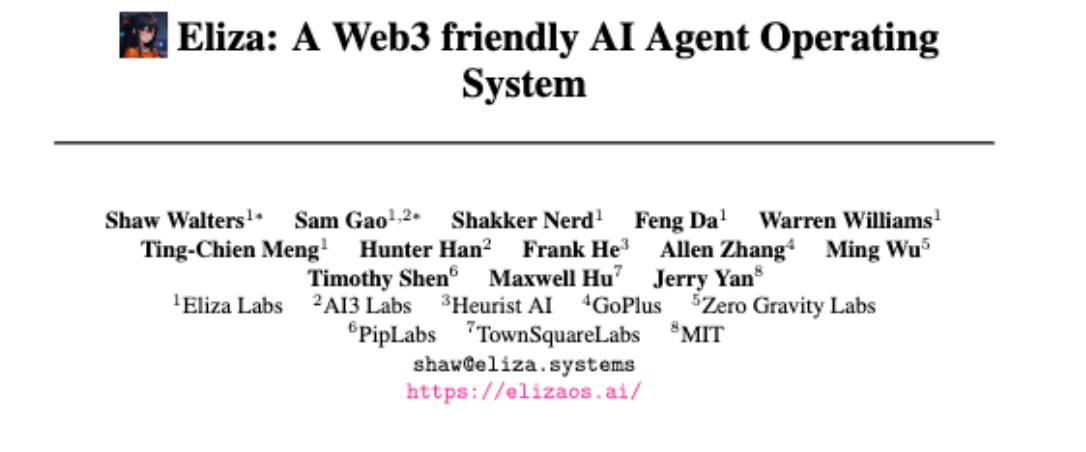
1. Why do you want to be Eliza?
Note that the editor believes that the premise of thinking is to delineate the scope---that is, in the field of encryption or Web3, why to build Eliza, rather than comparing this framework with a larger range of similar AI frameworks.
Following this line of thought, the introduction and background sections of the technical white paper actually give a good answer to this question:
In the intersection of AI and Web3, there has always been an obvious gap: the lack of a proxy framework that can perfectly integrate Web3 applications.
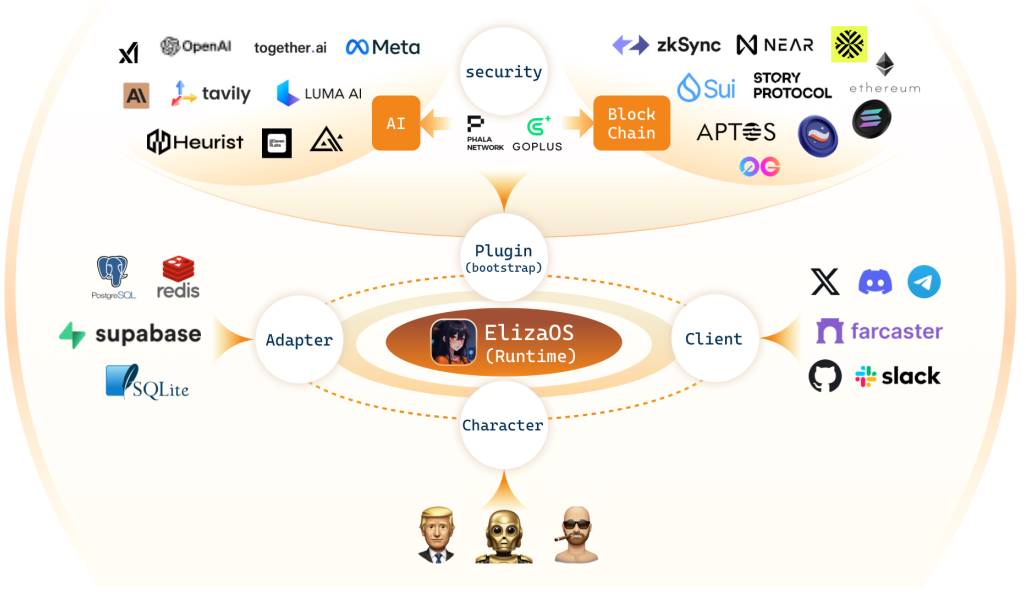
Specifically, the white paper believes that the Web3 field faces three main challenges:
- The Complexity of Decentralized Transactions With the vigorous development of public chains such as Ethereum, Solana, and BASE, managing assets and executing transactions on different chains has become increasingly challenging. Although there are some trading platforms on the market, the basic functions of these platforms are often not enough for intermediate and advanced users with customization needs.
- Value Mining of On-Chain Data The blockchain contains a large amount of valuable information, from basic indicators such as currency holding address changes, token prices, market value, etc., to deeper indicators such as whale account proportion, market maker style and other advanced indicators. . How to effectively transform these complex data into valuable insights is an urgent problem that needs to be solved
- Fragmentation of social media information For the Web3 industry, social platforms such as Twitter, Discord, and Farcaster are important channels for obtaining information. However, as the number of opinion leaders (KOL) increases, information becomes more and more fragmented. How to obtain valuable insights in the flood of information has become a common challenge for every trader.
It is based on these practical needs that Eliza was born. As the first open source Web3-friendly AI agent operating system, Eliza adopts a modular design to allow developers and users to customize solutions according to their own needs.
Eliza tries to lower the threshold for ordinary users to use advanced AI functions and build their own AI agents without deep programming experience.
At the same time, the white paper also compares itself with several other common AI frameworks. The following table can clearly see that in terms of Web3 support, Eliza claims that hers is the most suitable, and this is what the entire white paper aims to achieve. key points conveyed.

2.Eliza’s design concept and technological innovation
Three design principles: simple but not simple
Eliza’s success is no accident. At the beginning of the design, the team established three core principles:
-
Web3 developers give priority to the fact that Web3 mainly uses JavaScript/TypeScript for development, and Eliza chose TypeScript as the development language. This not only allows developers to use familiar tools, but also allows them to easily integrate blockchain functionality into existing web applications. To put it simply, it allows Web3 developers to "use it out of the box."
-
Modular plug-in design Eliza decomposes the system into a core runtime and four key components:
-
Adapter (data adapter)
-
Character (agent personality)
-
Client (message interaction)
-
Plugin (general function)
This design gives developers the freedom to add their own plugins, clients, roles, and adapters without having to worry about the details of the core runtime. This also enables Eliza to support the widest range of model providers (e.g. OpenAI, Llama, Qwen, etc.), platform integrations (Twitter, Discord, Telegram, etc.) and chain compatibility (Solana, Ethereum, Ton, etc.).
- It’s better to be simple than complicated:
With limited engineering resources, keeping the internal implementation simple can save time for developing new features, adapting to new scenarios, and keeping up with the rapid development of the AI and Web3 fields.
Technological innovation: both internal and external
In terms of specific implementation, Eliza's innovation is divided into two dimensions: internal enhancement and external expansion.
- Internal Enhancement In order to improve the thinking ability of the AI model, Eliza has integrated a number of cutting-edge technologies:
-
Chain-of-Thoughts :
-
Technical definition: Introducing step-by-step explanations
-
Popular understanding: Just like writing down the process for solving math problems, AI will also write out the thinking process step by step instead of directly giving the answer. Not only will the results be more accurate, but humans will also be able to understand how the AI reaches its conclusions.
-
-
Tree-of-Thoughts :
-
Technical definition: Allow branching to explore multiple solutions
-
Popular understanding: Just like considering multiple possible moves when playing chess, AI will explore multiple solutions at the same time and then choose the optimal one. It's like choosing the best branch on the tree of thought
-
-
Graph-of-Thoughts :
-
Technical definition: Connecting reasoning paths
-
Popular understanding: Think of the problem as a network, with various ideas connected to each other. Just like when we solve complex problems, we connect various related ideas to form a mind map
-
-
Layer-of-Thoughts :
-
Technical definition: Hierarchical reasoning AI
-
Popular understanding: Like a filter, it divides the thinking process into different levels. Just like when we solve a problem, we first consider the general direction, then refine it to the specific details, and proceed layer by layer.
-
- External extensions In order to enhance practical problem-solving capabilities, Eliza integrates a variety of external capabilities:
-
RAG (Retrieval Augmentation Generation) :
-
Technical definition: Enhance generation capabilities through retrieval
-
Popular understanding: Just like students can consult textbooks when doing homework, AI can also consult its "database" when answering questions to ensure more accurate answers
-
-
Vector database :
-
Technical definition: Storing and retrieving structured data
-
Popular understanding: It is equivalent to an AI "library" that can quickly find similar content. For example, if you say "I want to find a poem about the moon", it can quickly find all related poems.
-
-
Web search :
-
Technical definition: Real-time acquisition of Internet information
-
Popular understanding: Let AI be able to search for the latest information on the Internet like humans, without being limited to a fixed range of knowledge
-
-
Text to image/video/3D model :
-
Technical definition: converting text descriptions into multimedia content
-
Popular understanding: Just like a painter can draw a painting based on text description, AI can generate pictures, videos, and even 3D models based on your description
-
Comparison with other frameworks in the Web3 space
In the current Web3 AI agent framework, Eliza shows obvious advantages. Based on feedback from over 50 AI researchers and senior blockchain developers, Eliza outperforms other frameworks in the following key metrics:
-
Model provider support
-
Chain compatibility status
-
Functional integrity
-
Social media integration
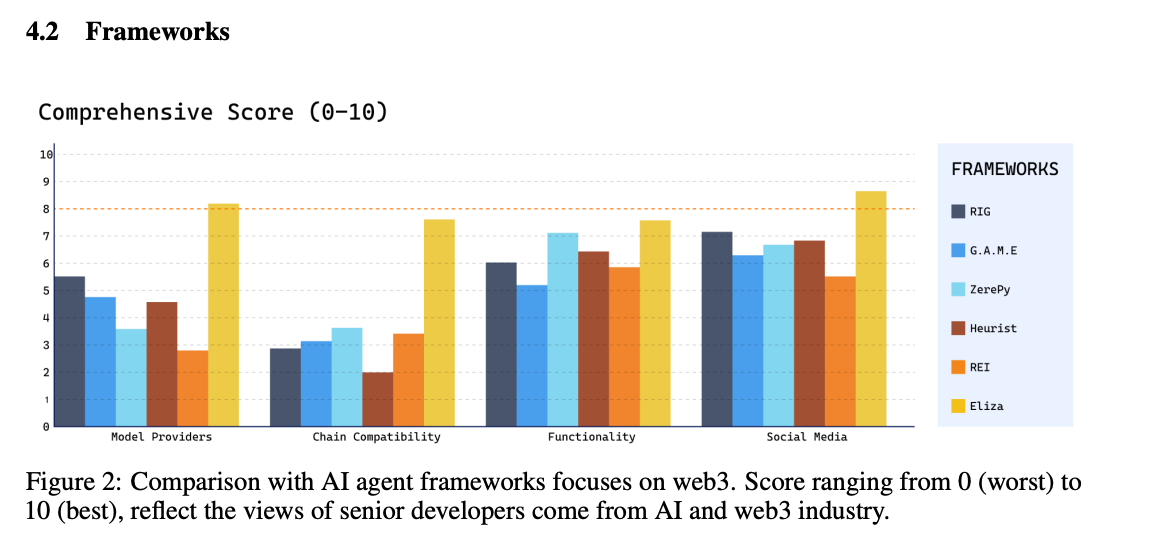
3.Eliza OS: A carefully crafted Web3 AI ecosystem
After understanding Eliza's design philosophy, let's take a look at how this framework works. Think of Eliza as a carefully designed system of Lego bricks, with each part fitting together perfectly while maintaining great flexibility.
Core Components: Five Key Roles
In Eliza's world, five core components work together to form a complete intelligent system.
- Agents: the protagonists of the system
They are like independent "digital assistants" responsible for handling various autonomous interactions. Each agent has its own "memory" and "personality" and can have coherent conversations and interactions with users through different channels such as Discord and Twitter.
- Character Files: The agent 's "personality"
To make these agents full of personality, you need the support of Character Files (role configuration). This is equivalent to the agent's "personal resume", which not only defines its identity and personality characteristics, but also specifies which models it can use (such as OpenAI, Anthropic) and what operations it can perform (such as blockchain transactions, NFT minting). Through carefully designed role configurations, each agent can display unique expertise and behavior.
- Providers: the agent 's "awareness system"
When interacting with the outside world, the agent needs Providers as its "awareness system". Just like humans need senses to perceive the world, providers provide agents with real-time information such as market data, wallet details, sentiment analysis, etc. to help them better understand the current environment and context.
- Actions: The agent 's "skill library"
Actions become the agent's "skill library" when specific actions need to be taken. From simple buy and sell orders to complex NFT generation, each operation undergoes strict security verification to ensure that it is foolproof when handling financial-related tasks. These skills allow agents to truly function in the Web3 world.
- Evaluators: the agent 's " decision-making system "
Finally, Evaluators serve as the agent's "decision-making system", responsible for evaluating the dialogue content, extracting important information, and helping the agent build long-term memory. It not only tracks goal completion progress, but also ensures coherence throughout the conversation.
Intelligent interaction: more than just a simple conversation
In terms of interaction, Eliza adopts a multi-layered understanding system, like an experienced translator, who not only understands the literal meaning, but also understands the context and intention of what is said. This system can accurately understand the real needs of users, maintain a consistent experience across different communication platforms, and flexibly adjust responses based on context.
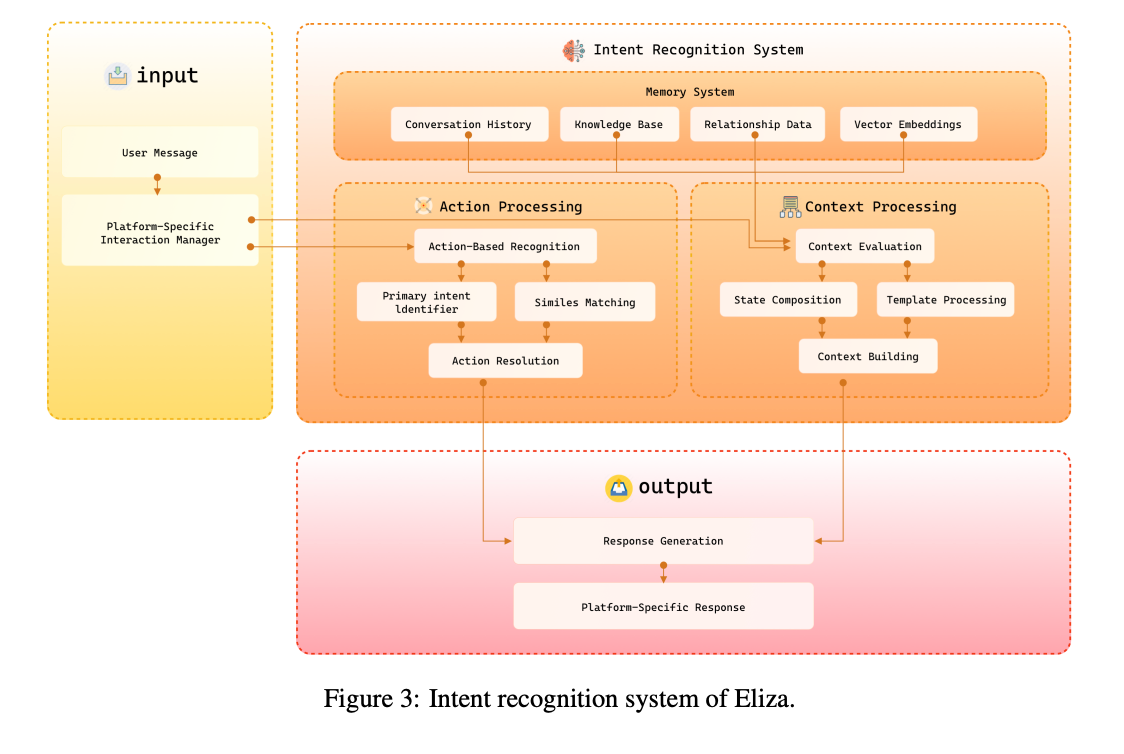
Plug-in system: unlimited expansion possibilities
Eliza's plug-in system is essentially a toolbox, bringing powerful extensibility to the entire framework. This extensibility is reflected in three directions: multimedia generation, Web3 integration, and infrastructure:
- In terms of multimedia generation, it can generate pictures, videos, and 3D models, supports the automatic generation of NFT series, and also provides picture description and analysis capabilities.
- In terms of Web3 integration, it supports multi-chain operations such as Ethereum and Solana, provides a complete suite of trading functions, and integrates various DeFi operations.
- In terms of infrastructure, it provides basic capabilities such as browser services, document processing, and speech-to-text.
Through this modular design, Eliza not only maintains the stability of the system, but also provides developers with nearly unlimited expansion possibilities. This also enables Eliza to adapt to new needs and scenarios that are constantly emerging in the Web3 world.
4. How strong is Eliza? See the truth from data
When a new technology framework appears, what everyone is most concerned about is often its actual performance. Eliza gives a candid answer here.
In the GAIA benchmark test, a test platform specifically designed to evaluate the ability of AI agents to solve real-world problems, Eliza showed impressive performance. This test does not test simple question-and-answer abilities, but requires the AI agent to have multiple skills such as logical reasoning, multi-modal processing, web browsing, and tool use.
Although in the test, Eliza's score (19.42%) is still far behind the current top solutions, considering that it is a framework focusing on the Web3 field, this result is already quite impressive. Especially in the processing of basic tasks (Level 1), Eliza achieved a completion rate of 32.21%, showing its solid basic capabilities.
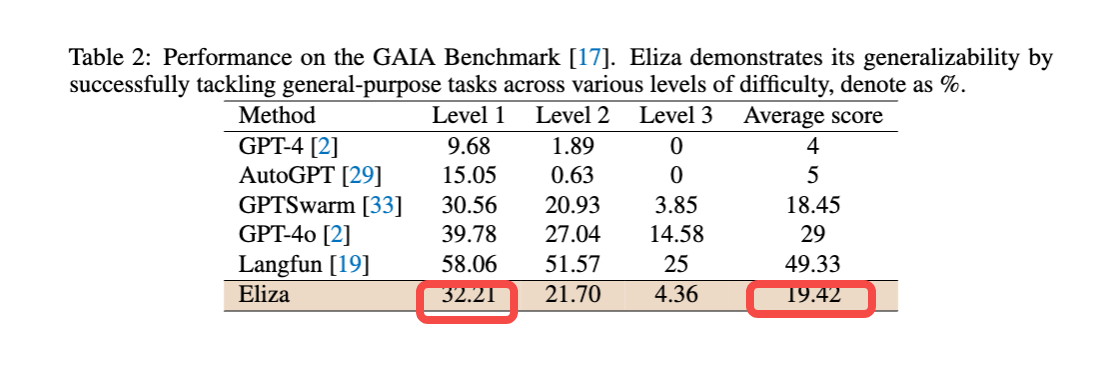
Web3 Land: Groundbreaking Standards Setters
What is more noteworthy is that Eliza actually plays the role of "standard setter" in the Web3 field. Since Web3-oriented AI systems are still in their early stages, Eliza took the lead in proposing a complete evaluation standard system, pointing out the development direction for the entire industry.
This evaluation system is divided into three levels. The white paper calls it the Web3 AI version of the "Turing Test":
- Basic capabilities: including wallet creation, token trading, smart contract interaction and other basic operations
- Advanced functions: Integrate the latest AI technology, such as text to video/3D, RAG support, etc.
- Advanced features: capable of autonomous planning and reasoning based on user instructions to achieve truly intelligent decision-making
At present, Eliza has successfully implemented all functions of the basic level and is moving towards the advanced level. The team stated that they firmly believe that a fully autonomous AI agent system will be possible within the next few years.
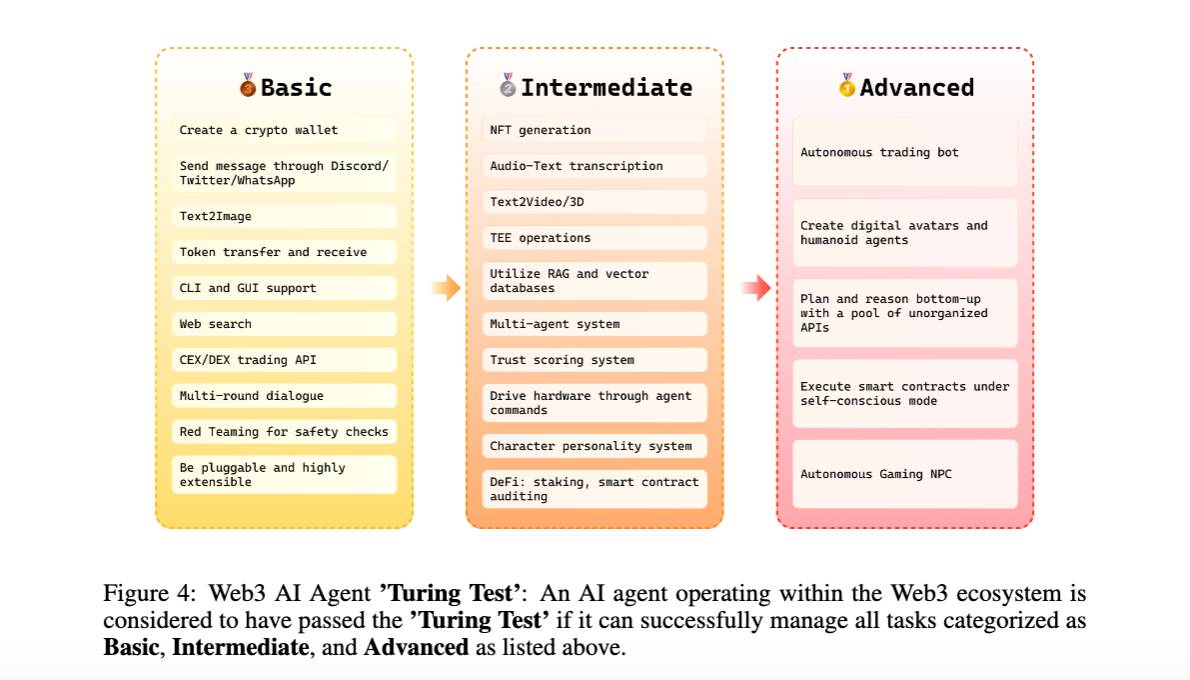
5. Practical application: The market votes with real money
The original white paper also has a section about code display, which is used to illustrate the practical applications that can be made using the framework. Considering the difficulty of understanding and technical details, it is skipped here and only shows a more macro-level practical application.
According to the white paper, as of January 2025, several important Web3 projects have built their AI agent systems based on Eliza, and the total market value of these partners exceeds US$20 billion.
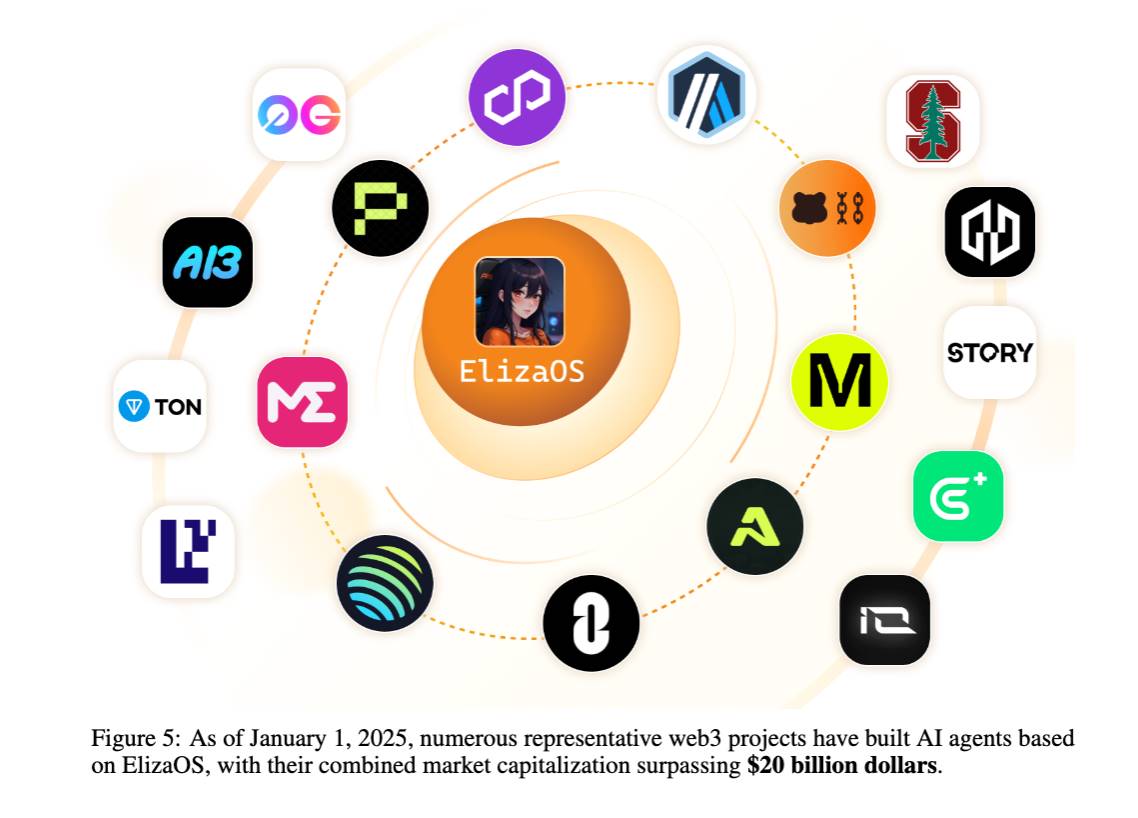
This number itself may be the market’s best endorsement of Eliza’s technical strength.
More importantly, the Eliza team is confident about the future. They believe that as these "intelligent agents" continue to evolve, we will see a new era of multiple AI units working together. Eliza is paving the way for what Anthropic CEO Dario Amodei calls the "genius data center" vision.
6. Existing limitations and future prospects: Honest self-analysis
No technical framework can be perfect, and the Eliza team frankly pointed out the limitations of the current framework in the white paper.
Three major challenges to be solved
Lack of workflow system: Just like a skilled assistant needs a standardized workflow, when developers want to implement some routine tasks (such as regularly aggregating data from multiple sources), the existing Eliza framework still has No ready-made solutions are available. For such needs, you may still need to use a workflow system with a graphical interface such as Dify or Coze.
Performance issues in multi-agent systems. As the number of agents increases, the context and memory content that the system needs to process increases exponentially. Especially when processing a large number of input and output tasks, how to balance computing overhead and operating efficiency is still a technical problem to be solved.
Expansion needs for multi-language support. Currently, Eliza is mainly based on TypeScript, but to attract developers from more fields to join, it needs to expand its support for other programming languages such as Python and Rust.
Outlook: Creating a new era of decentralized AI
Despite these limitations, Eliza is much more than a technical framework in itself. It represents a pioneering attempt to deeply integrate AI technology and Web3 applications.
By designing each functional module as a standard TypeScript program, Eliza ensures that users have complete control over the system. At the same time, it also provides seamless integration capabilities with blockchain data and smart contracts. This design not only ensures security, but also maintains strong scalability.
As stated at the end of the white paper, the possibilities of Eliza are only limited by the imagination of the user. As AI and Web3 technologies continue to evolve, Eliza will continue to develop and continue to lead the development direction of decentralized AI.


 chaincatcher
chaincatcher